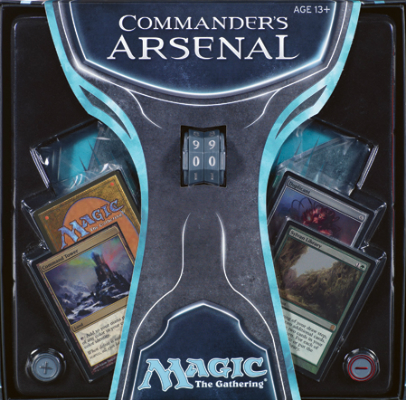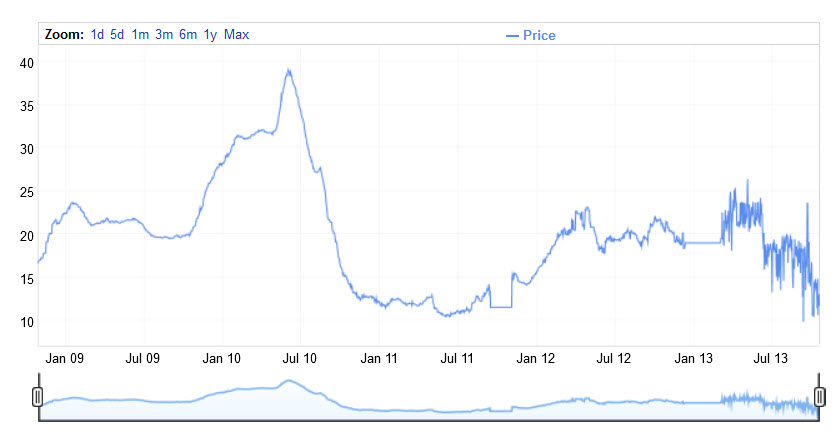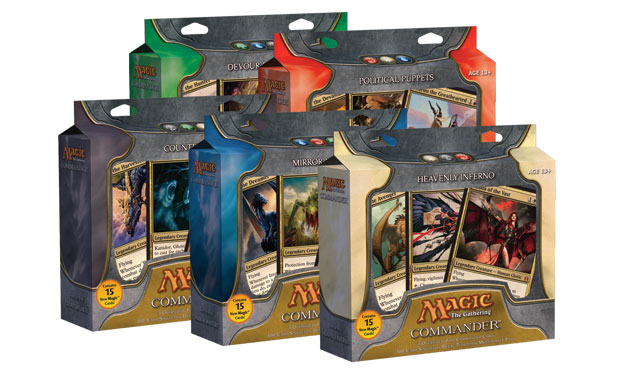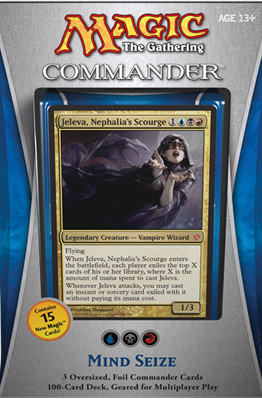Today I’m drawing a proverbial line in the sand. On Friday, November 1st, the second wave of M:tG Commander decks will be released to its adoring public for consumption at the fair and economical MSRP of $29.99. Unfortunately, before we even get to enjoy all the goofy, powerful, and unique cards they have to offer, there’s already reason to give pause. Because of links like this. And this. And this. What you’ll notice is that none of those places are selling any of the five new decks for even close to retail price.
But this is fine you say. This is expected you say. Pre-orders from the “big” website sellers are always selling anything besides sealed boosters at overpriced and unrealistic amounts. And if we were talking about singles, you’d be right – the pre-order markup on singles prices by most places is generally downright laughable. You’d think after so many years a few places would figure out that not every planeswalker is an automatic $40 pre-order value, but I digress. So, then, what’s the actual hubbub?
Collectors and Customers
 First, to better convey the issue at hand, it’s helpful to understand that Wizards’ supplementary sealed product for Magic falls into two categories: those aimed at collectors and those for casual consumption. Collector material is limited edition products that are only sold to brick-and-mortar stores. They’re doled out in small quantities with a fixed print run, and even the MSRP on these items are with a premium. This includes product like the From the Vault series or the special Commander’s Arsenal set (although it was poorly conveyed as such).
First, to better convey the issue at hand, it’s helpful to understand that Wizards’ supplementary sealed product for Magic falls into two categories: those aimed at collectors and those for casual consumption. Collector material is limited edition products that are only sold to brick-and-mortar stores. They’re doled out in small quantities with a fixed print run, and even the MSRP on these items are with a premium. This includes product like the From the Vault series or the special Commander’s Arsenal set (although it was poorly conveyed as such).
These items are essentially gifts to store owners for their continued existence, providing a means of making a little extra money by selling the product to players and collectors willing to spend at higher than average levels. While the rest of us may bemoan the practice when one such product comes out that entices us and the store’s asking price is two to five times the MSRP, I can still accept the nature of such items. They aren’t made in high quantity, and you’re paying for the privilege of having a limited edition item. It also means I’m not going to end up buying it.
Casual consumption products, on the other hand, consist mostly of pre-constructed decks. Whether they’re intro decks, event decks, theme decks, or duel decks, this stuff is far more accessible. They’re printed in robust quantities (Wizards is not against printing even more if initial runs sell quickly), they’re aimed at the general playing population, they’re sold both in stores and online, and you can readily find them at MSRP. As the Commander decks are part of this latter group, they should be treated as such.
When the original Commander decks were released in 2011, no one was quite sure what to expect for a reaction. Commander until that point had been a largely unrecognized format, albeit one that had been growing in popularity for some time. Interest reached a critical mass when there was enough people inside WotC to decide that their seasonal supplementary casual product should be Commander. These five decks contained a treasure trove of powerful cards, replete with useful reprints and unique cards to that set. And they all sold decently at MSRP. The asking price for certain decks (namely Heavenly Inferno and Counterpunch) didn’t shoot up until well after they had been released on the market for awhile and scarcity had started to become an issue. This aspect of raising prices is expected, and it too is a fair move in my opinion – lest you begin to think my ire is with capitalism writ large.
What I refuse to accept, however, is artificial scarcity. Whether generated (because an individual entity tries to corner the market on an item simply to keep prices high), or faked (by creating the illusion that an item is in short supply to get uninformed people to pay the higher prices), it’s a less than admirable trait of the free market. It may be perfectly legal, but it’s hardly fair or ethical. That said, profits in a competitive marketplace aren’t generally made by being fair and ethical. Still, we don’t have to like it. There’s a reason I spend my free time as a hobby enthusiast and not a venture capitalist.
Therefore, in an effort to stave off artificial scarcity, I would like to help provide you with a deep, dark, not-so-secret secret about casual Magic products. And it starts with Elspeth.
A Knight’s Tale
In the fall of 2010, Wizards released a little duel deck called Elspeth vs. Tezzeret. Prior to this point, Elspeth, Knight-Errant had only been seen in the Alara block. Alara was the first block to release new planeswalkers since the Lorwyn 5, and Elspeth was the runaway favorite by tournament and casual players alike. She was at a mere 4 CMC, very powerful, and she was the first planeswalker to break from the Plus-Minus-Minus pattern of loyalty abilities. Her value soared to upwards of $40. So when it was announced that you would be able to get her, another planeswalker, and deck for each of them, all at cost of $19.99, people were ecstatic.

The real fear from sellers was that the value of Elspeth would drop. It did. She went from $40 to just over $10 in six months. In time, the lack of the duel deck availability drove her back to $25, where she stayed until being reprinted again in Modern Masters and returning to $10-15 levels.
Source: Black Lotus Project
Except, when it finally hit the shelves, not everyone was being shown the option for a 20 dollar product. Right out of the gate stores were selling it for $30-40. Players bought them from their local game stores at those numbers because they were being presented with the perception that the only other choice was to not have it at all.
The thing was, there actually wasn’t a scarcity issue due to lack of supply. There was simply a rise in demand compared to past duel decks, and stores – completely within their right – sought to make a few extra bucks on them. In time, a genuine scarcity issue arose, but by then you already had a copy, or you had given up.
Of course, it’s also perfectly within our rights as consumers to not accept that price. I certainly didn’t.
My local Magic group at the time, like much of the community, was intrigued by the Elspeth vs. Tezzeret decks. Casual players all, none of my circle is willing to spend more than a few dollars on any single card, let alone for what was the hottest planeswalker of its day (this was prior to Jace, the Mind Sculptor after all). They were, however, excited for the option to have access to a copy of Elspeth, Tezzeret, and a bunch of other cards for a reasonable price. There was much dismay amongst them when it was revealed that almost all of the local game stores were not going below $30 from the onset. For Magic players on shoestring budgets, the extra $10 was a deal breaker.
 I have no shortage of local game stores to support in my area. There are a dozen game and comic stores within about a half hour radius of where I live that I know of – and likely a few more that I don’t. I’m an avid gamer of all stripes, and I try to help a FLGS where and when I can. However, I am also admittedly a bit of a miser when it comes to the purchase and sale of Magic cards. When you invest almost twenty years of time and more cash than you’d care to calculate into a known money sink, you either find a career to provide you with lots of disposable income, or you learn to be wise in your spending. I personally had a difficult enough time justifying the $20 price tag myself, already having just about all of the cards in the decks to begin with, but I made the decision that I could use more and decided to go for it. Until I saw the higher rates.
I have no shortage of local game stores to support in my area. There are a dozen game and comic stores within about a half hour radius of where I live that I know of – and likely a few more that I don’t. I’m an avid gamer of all stripes, and I try to help a FLGS where and when I can. However, I am also admittedly a bit of a miser when it comes to the purchase and sale of Magic cards. When you invest almost twenty years of time and more cash than you’d care to calculate into a known money sink, you either find a career to provide you with lots of disposable income, or you learn to be wise in your spending. I personally had a difficult enough time justifying the $20 price tag myself, already having just about all of the cards in the decks to begin with, but I made the decision that I could use more and decided to go for it. Until I saw the higher rates.
Unfortunately, being a FLGS is difficult as they continue to wrestle with competition from online retailers. Even more unfortunately, though, is that most have succumb to the mentality that if you can’t beat them, join them. That is, most local game stores that traffic in Magic products use places like Star City or Troll & Toad as benchmarks for the market as a whole. If those folks are listing items at a higher price (as the largest ones almost always do), store owners feel compelled to shift their prices closer than establish different benchmarks. This causes the vast majority of retail and aftermarket prices to be set artificially high.
I’ve personally tried to suggest alternate pricing models to some of my local game stores in an effort to make their locales more enticing and to help break the arbitrary baselines on items that are set by a few places simply because they have name recognition and a little industry clout. Alas, my explanations to many of them on why they shouldn’t be selling a card at $25 I can get elsewhere for $5 simply because that’s what the big dogs are asking for have fallen on deaf ears. Every. Single. Time. Whether it’s laziness or fear, many – though not all – fall in line with the online honchos. The moment I find out a game shop uses someone like Star City or Channel Fireball as their price guide, I stop bothering to look at their goods as I know I will find no deals there. The ones that don’t are the ones that I choose to spend my money at.
Even still, at the time, getting a $20 Elspeth vs Tezzeret was difficult. The hype was too high, and the lure of extra cash too great. None of the game stores budged from the $30+ amounts. So, since the online community and my local game stores were not selling it for the price I wanted, I went elsewhere. I went to Walmart.
Voting With Your Wallet
Yes, the terrible, horrible secret is out. Most Walmarts and Targets sell Magic products – especially sealed product. And they always sell them at MSRP. Sure, they often won’t have the same volume as other locations, but if they have it, you won’t pay a premium because of insider tactics. Places like Walmart and Target are so large they don’t have the time or interest in worrying about the nuanced fluctuations of a game that most employees, let alone the customer base, have barely ever heard of. Yes, outside of the echo chamber, gaming is still a niche thing lest we forget.
Now, I have the same issues with big box places as many do, and I’m aware in some respects that they are a danger to the longevity of local storefronts, gaming stores included. I’d much rather go to a game shop and spend an extra $5 on a board game than get one at Target. However, in this case I’m not buying something that has flooded the marketplace with high volume to drive down cost. With Magic, I have no loyalty other than to my budget. In the case of Elspeth, I wasn’t buying a $20 item for $10. I was buying it there for $20 – the fair market price. There’s a certain bit of irony there you have to admit.
Sure enough, I checked out my local Walmart at the time, and I found a display for them in the gaming section. They had six copies of Elspeth vs Tezzeret. I bought all six. For $20 each. Five friends and I each got exactly what we wanted in the end. Sure, I could have thrown them on eBay, but A) I’d prefer not to add to the problem and B) I’d rather ensure that other fans of the game get them for a reasonable price than make a few extra bucks on the side.
In a few days, the new Commander sets are due out, and their hype matches that of the Elspeth duel deck. Commander has grown exponentially more popular since when the first five decks came out in 2011, and many places selling them know they have a commodity on their hands that will sell. So, they’re doing the exact same thing we’ve seen before: drive up the asking price. Some of those inflated numbers are normal pre-order silliness, but much of it is simply trying to take advantage of the interest in a casual format. Sure, they’ll try to claim that it’s due to demand being up, but so is supply. Again, Wizards has already stated that they will print more of them if they sell well. That’s pretty much a given. Therefore, there’s no reason to may a premium for it.
As consumers, I ask that you avoid paying higher than MSRP for the new Commander decks. If your local game store is trying to gouge you, try to get them to sell them at the $30 price tag they should be at. Tell them they don’t have to be lockstep with the online places. And if they don’t budge, tell them you’ll just go to Walmart. Retailers are welcome to sell their wares at whatever price they wish. Consumers have every right to refuse. Help keep Commander as cheap and casual as it’s supposed to be. Keep Commander at MSRP by only buying it at MSRP.


